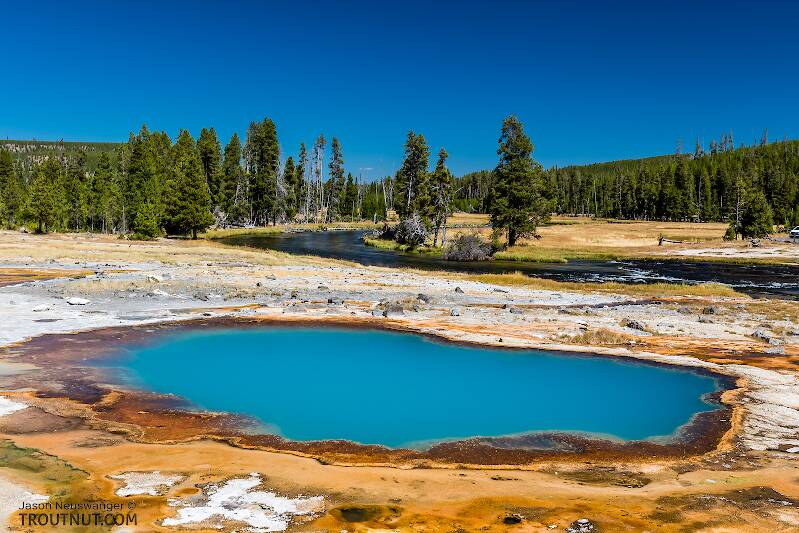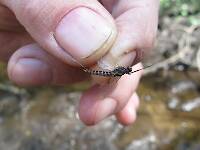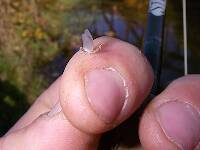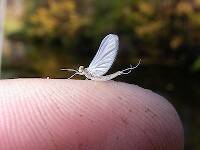
Blue-winged Olives
Baetis
Tiny Baetis mayflies are perhaps the most commonly encountered and imitated by anglers on all American trout streams due to their great abundance, widespread distribution, and trout-friendly emergence habits.
Featured on the forum

Some characteristics from the microscope images for the tentative species id: The postero-lateral projections are found only on segment 9, not segment 8. Based on the key in Jacobus et al. (2014), it appears to key to Neoleptophlebia adoptiva or Neoleptophlebia heteronea, same as this specimen with pretty different abdominal markings. However, distinguishing between those calls for comparing the lengths of the second and third segment of the labial palp, and this one (like the other one) only seems to have two segments. So I'm stuck on them both. It's likely that the fact that they're immature nymphs stymies identification in some important way.

Troutnut is a project started in 2003 by salmonid ecologist Jason "Troutnut" Neuswanger to help anglers and
fly tyers unabashedly embrace the entomological side of the sport. Learn more about Troutnut or
support the project for an enhanced experience here.
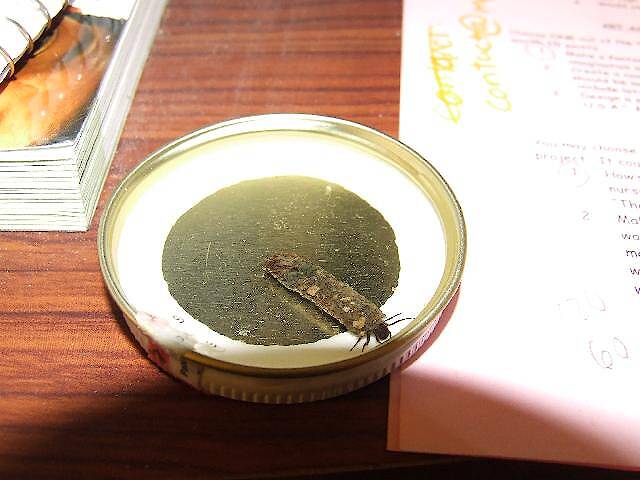
Dryfly on Mar 18, 2007March 18th, 2007, 7:39 am EDT
caught in riffle about 2 cm long any ideas on what genus it might be
Taxon on Mar 18, 2007March 18th, 2007, 11:15 am EDT
Dryfly-
It appears that the larval case is flattened on the bottom, as opposed to being cylindrical. Is that true? It also appears that the case is made entirely of plant material, as opposed having rock particles incorporated in its construction. Is that true?
It appears that the larval case is flattened on the bottom, as opposed to being cylindrical. Is that true? It also appears that the case is made entirely of plant material, as opposed having rock particles incorporated in its construction. Is that true?
Dryfly on Mar 18, 2007March 18th, 2007, 11:32 am EDT
taxon
it is under water so that is why it appears to be flat.
it is cylindrical
the case it made primarily with fine pieces of rock with some sticks toward the back
this may help I collected it in se minnesota
it is under water so that is why it appears to be flat.
it is cylindrical
the case it made primarily with fine pieces of rock with some sticks toward the back
this may help I collected it in se minnesota
GONZO on Mar 18, 2007March 18th, 2007, 12:23 pm EDT
Roger, I was also deceived by the optical illusion caused by the water.
Dryfly, if you could extract the larva from the case without damage and rephotograph it, the identification should be easier. Perhaps Roger, Konchu, or David would then be better equipped to nail it down with the additional information that would be provided.
Dryfly, if you could extract the larva from the case without damage and rephotograph it, the identification should be easier. Perhaps Roger, Konchu, or David would then be better equipped to nail it down with the additional information that would be provided.
Taxon on Mar 18, 2007March 18th, 2007, 1:50 pm EDT
Dryfly-
The only family of caddisflies (of which I am aware), which builds stout, cylindrical, not gradually tapered or curved cases, made mainly or entirely of rock fragments, and would also be as large as your specimen is Limnephilidae.
The following Limnephilidae species reside in Minnesota:
Frenesia missa
Limnephilus indivisus
Limnephilus sericeus
Limnephilus submonilifer
Pycnopsyche guttifera
Pycnopsyche lepida
Pycnopsyche scabripennis
Platycentropus radiatus
Onocosmoecus unicolor
Hesperophylax designatus
Hydatophylax argus
Of those, only Fresnia missa (Dot-Winged Sedge), and Hesperophylax designatus (Silver Stripe Sedge) build cases resembling those of your specimen. Fresnia missa only reaches a length of 13.5 mm, whereas Hesperophylax designatus reaches a length of 20 mm., so that’s what my guess would be.
The only family of caddisflies (of which I am aware), which builds stout, cylindrical, not gradually tapered or curved cases, made mainly or entirely of rock fragments, and would also be as large as your specimen is Limnephilidae.
The following Limnephilidae species reside in Minnesota:
Frenesia missa
Limnephilus indivisus
Limnephilus sericeus
Limnephilus submonilifer
Pycnopsyche guttifera
Pycnopsyche lepida
Pycnopsyche scabripennis
Platycentropus radiatus
Onocosmoecus unicolor
Hesperophylax designatus
Hydatophylax argus
Of those, only Fresnia missa (Dot-Winged Sedge), and Hesperophylax designatus (Silver Stripe Sedge) build cases resembling those of your specimen. Fresnia missa only reaches a length of 13.5 mm, whereas Hesperophylax designatus reaches a length of 20 mm., so that’s what my guess would be.
GONZO on Mar 18, 2007March 18th, 2007, 3:57 pm EDT
Really nice deductive reasoning, Roger!
Taxon on Mar 18, 2007March 18th, 2007, 4:57 pm EDT
Really nice deductive reasoning, Roger!
Thanks, Gonzo. However, there is (at least) one caddisfly specialist who frequents this site, so I'm kind of waiting for "the other foot" to fall!
GONZO on Mar 18, 2007March 18th, 2007, 5:26 pm EDT
I know what you mean, Roger, but I still think it was an impressive application of both logic and resources. :)
Dryfly on Mar 19, 2007March 19th, 2007, 12:08 am EDT
thanks taxon and gonzo for your quick replies
I appreciate it
i'll post pics of the larva out of the case later today
I appreciate it
i'll post pics of the larva out of the case later today
Quick Reply
Related Discussions
Topic
Replies
Last Reply
0
Sep 23, 2006
by Litobrancha
by Litobrancha
0
Sep 23, 2006
by Litobrancha
by Litobrancha

